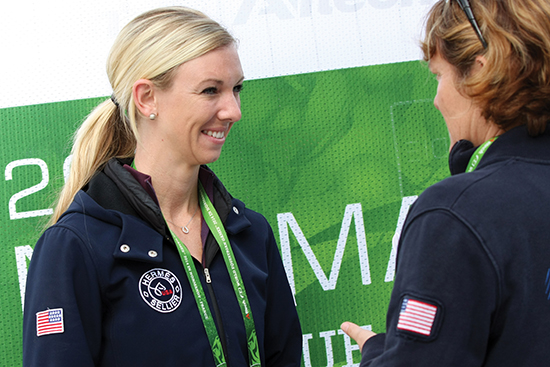 Ilse Schwarz spoke with Laura Graves on the morning of the Freestyle at the World Equestrian Games, Normandy back in 2014. At the time, Laura was the ‘unknown’ element of team USA and no-one was more surprised than her to be entering the day in eighth place…
Ilse Schwarz spoke with Laura Graves on the morning of the Freestyle at the World Equestrian Games, Normandy back in 2014. At the time, Laura was the ‘unknown’ element of team USA and no-one was more surprised than her to be entering the day in eighth place…
Ilse: Before we start, congratulations on getting a 10 for your pirouette left in the Special…
Laura: I did? I got a 10?
We do a quick delighted mutual high 5 and the bubbly 27-year-old from Geneva, Florida (pop. 2940) emerges.
Laura: I haven’t even seen my tests yet… it has been crazy.
Ilse: How does it feel to be at the World Equestrian Games, preparing to go into the freestyle… it must be like the icing on the cake of the whole experience?
Laura: For sure it is the icing at this point, actually it is like the little flowers, the decorations you put on top of the icing. We had a good ride in the Grand Prix, going into the Special, and then a really good Special ride, the score reflected it as well which was nice and now we go into the Freestyle!
I will go in and try to have a good time. I know we have a lot to learn so I am going to go in knowing that it will be a learning experience.
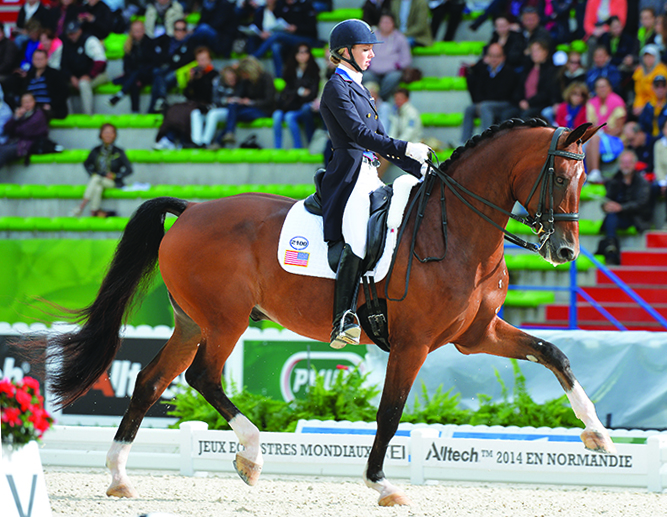
Ilse: Are you going to be ‘going for it’?
Laura: Oh we’re going for it! I can’t help but go for it, it’s in my nature, but I just also have to be aware that it’s a new freestyle, we are new at freestyles, we’re green at this whole thing but we are definitely going to give it all we’ve got.
Ilse: I hear it is new choreography?
Laura: A little bit. We’ve moved around some of the pieces, it just wasn’t flowing the way I wanted it to and if you look at a lot of the top freestyles now they have some similar characteristics. So we’ve taken a lot of these pieces that the judges seem to like, such as the passage half pass to trot half pass, the extended trot to a transition to, say, piaffe. It still needs more technical difficulty, but I am very aware that once it actually looks like it is difficult and you lose the flow of the ride that you are on the wrong track.
Ilse: How does it feel to be on the USA Team?
Laura: Being on the team is awesome. I keep saying that I couldn’t imagine being over here on my own. I don’t speak any other languages and especially having a horse over here knowing how to get feed, how to transport your horse, knowing that the shows don’t provide you with numbers for your bridle, a collection of little things like that. It has been so great to have people around me, not just here in France, but through the whole trip who have said “let me help you with this, you can borrow mine, take mine”
Ilse: When did it become reality for you, you’re at the WEG, it’s really happening?
Laura: After my ride on Tuesday in the Grand Prix, that was the big bang for us. I have been on the team since the USA National Championships in New Jersey in June, but then I just had to think about getting to Europe, making sure my horse was healthy here, then we had to get to Austria then we had to think about Aachen, and then finally we were here and after that ride it was real. Then I know I had made a team!
Ilse: Let’s talk about you and Verdades ( Diddy). Give me a LONG history of your riding. I keep getting asked by people “Your American girl, she rides so beautifully, where has she trained, where did she come from?” When did you start riding?
Laura: I didn’t start riding until I was maybe 10 years old. We had ponies in our backyard in Vermont and I just wanted to do the in-hand stuff. I was in 4H (an agricultural club for kids) and I just wanted to groom the ponies and present them and really never wanted to ride. Then one day I decided I WOULD like to ride so I took some 4H riding lessons and went to some open riding shows where you do like 15 classes a day and you do the equitation, and the pleasure, all on free horses that we (my parents and I) had scooped up from people along the way. Then my parents purchased my first horse for me when I was in 6th grade. A little 15hh Quarter horse, he was a 4yo at the time and together we worked through 4th level (advanced). Quarter horses are just not built to really maintain in the dressage sport, so we retired him and along the way we had also purchased Diddy (Florett AS x Goya). I was 15, and he was a foal so he had to grow up for a while before we got to work, and it was, ummm, a struggle.
He was a really difficult horse, not so much with teaching him to be ridden, but with the normal things such as tacking him up, he was afraid of saddle pads until he was 6 yo. He is an honest horse so it was not that he was being silly or stubborn. He would actually shake. Velcro, the sound of velcro terrified him so he couldn’t wear any boots, as at the sound of velcro he would try to climb out over his stall walls. We didn’t cross tie him as he was afraid of so many things. Clippers… until this year I haven’t been able to clip him. So he would be sedated once a year for a body clip and that was it! So I had to be really patient with him.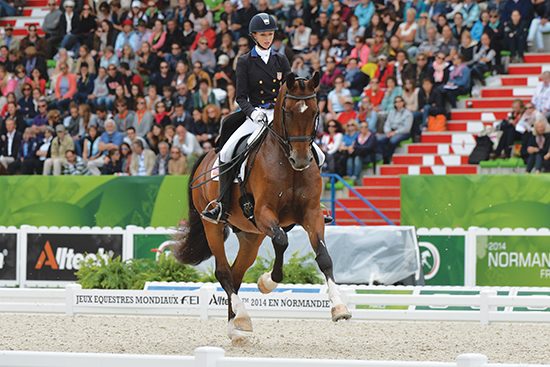
Ilse: Did you do any of the young horse classes? The lower level tests?
Laura: Because he was so sensitive, he has always been nice to ride. With that sensitivity it was easy to teach him to move away from leg pressure, he was always hot to those aids. But for a young horse that can really be a dangerous thing to take to a show. To be perfectly honest it was even sometimes a dangerous thing when he was doing small tour. Not knowing at the gear check what he was going to do with the rubber gloves used for the bit check. So definitely no young horse classes. We took him out for the first time at 3rd level (medium) and he did well. The next year we did PSG with mixed results. When he was good, it was good, but then he would spook at something and it would ruin the whole test.
Ilse: When did you know “ok, I know that I can start to get some reliability with him?”
Laura: Probably not until ummm…. he became pretty reliable at the small tour but it was a reliability we had to create with a bit of exhaustion. This is not the way I like to work, I like my horse to be excited to work, but you can’t have him so excited that he starts to make mistakes and tries to jump out of the arena. So probably not until I did the US finals in November 2013 where I came out at Intermediaire II. That was where anyone could hand walk him without worry, he could be loaded on the trailer easily. I don’t have to be the one to tack him up.
It has actually been really different having somebody else looking after him here (in Caen). My groom knew him when I was based with Anne Gribbons, so that really helped the relationship. She braids him and everything, but I still wrap his legs at night and I am around as much as possible, but I can finally trust him with most things.
When I was still living in Vermont I took a lesson with Madeline Austin, her daughter is a Grand Prix rider. Madeline said, “you know you have an international quality horse here”. I was oblivious. I really had no idea. So at that stage I started applying for working student positions, late 2008, and finally I was accepted into Anne Gribbons working student program and I moved to Florida in the spring of 2009. I trained daily with her assistant, Tamara Brown, and would have a lesson with Anne 2-3 times a month, or when she was in town and I could afford it. She was travelling a lot with her obligations with the USA team and I paid to have lessons with her.
My parents were supportive in paying for Diddy’s board at Anne’s, but could only afford to do so for a limited time. After my first year there, I left for the summer of 2010 and returned to Vermont where I could be busy teaching and riding clients’ horses during the day and also worked a second job at night.
In this way, I was able to save enough money to return to Florida in the fall of 2010 with enough money for board and a couple shows. When I returned to Florida, I also began waitressing and bartending in the evenings so I could pursue my dressage goals.
Ilse: How did you make the transition to Debbie McDonald?
Laura: There came a point where I almost stopped riding. I had no money, and was not even able to pay basic bills. I would ride four horses a day, including tack up and put away, plus barn duties, and then at night I had to bartend /waitress to try to make ends meet. Eventually I couldn’t afford to show or take lessons, I had no enthusiasm to train and I couldn’t see a way forwards. I thought my horse wouldn’t care if he was in a field and I was basically ready to finish the dream. Then I met my boyfriend, Curt Maes. He was living on a farm, and he said, move in. I will fix up the barn for you and you can start your own business. I did.
I was on my own from December 2012 until December 2013. I had previously worked with Debbie at a clinic in Georgia and knew I wanted to work with her so it was exciting when she decided to spend last winter in Wellington, Florida. However, it wasn’t until January 2014 that I was able to see Debbie on any sort of regular basis.
Ilse: You also had some other drama with Diddy. He had a serious accident?
Laura: Diddy broke his jaw on the stall bars at the end of the summer in 2011. He underwent extensive surgery to pin and wire things in place while the bone healed. He didn’t eat for days! It was almost a month before he would even try to take a bite of grass. It was devastating. He was on 3 different medications 4 times a day plus the topical treatments for the open wounds.
His mouth and our connection was a constant struggle which really bit us in the butt at GP. On Debbie’s suggestion, I now work with Neue Schule bits and Diddy is BY FAR the best he has ever been. It is easy to look at bits and think they are the same, but the proof is when they are put to the test. He actually still has some rods and pins in his jaw. They will stay forever.
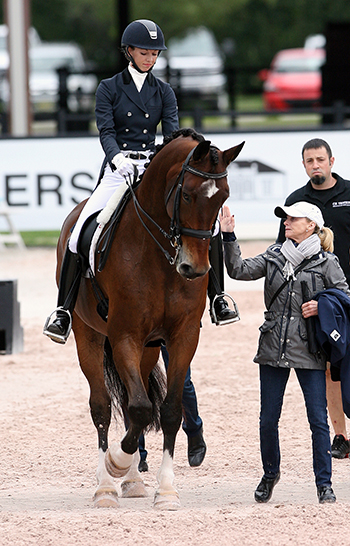
Ilse: Tell me about working with Debbie?
Laura: One of the biggest attributes of Debbie is that in her mind the first instinct is always, is the horse ok? That may mean playing with the bits, with saddle fit, checking soundness. She may say, today we should keep it light, perhaps he simply needs to go back to the barn, perhaps he needs a quick break, she visits all options before she says, ok, he’s misbehaving, time to deal with it. This is not so common in this industry. She is incredibly patient, but there is this other side of her that is like a killer competitor. She also finds time, for example, to go to Carl Hester’s training sessions to stay informed, and brings all her training home. She stays on top of what is needed to succeed in today’s competition. She keeps the competition and training relevant and keeps a good international perspective.
Ilse: Any specific movements Debbie has helped you with?
Laura: Of all the movements Debbie has helped me most with it is the piaffe. When I started with her he really didn’t piaffe. She took the time to figure out why it bothered him. It came down to keeping me calm through that training and just taking the time for him to understand the movement and not worry.
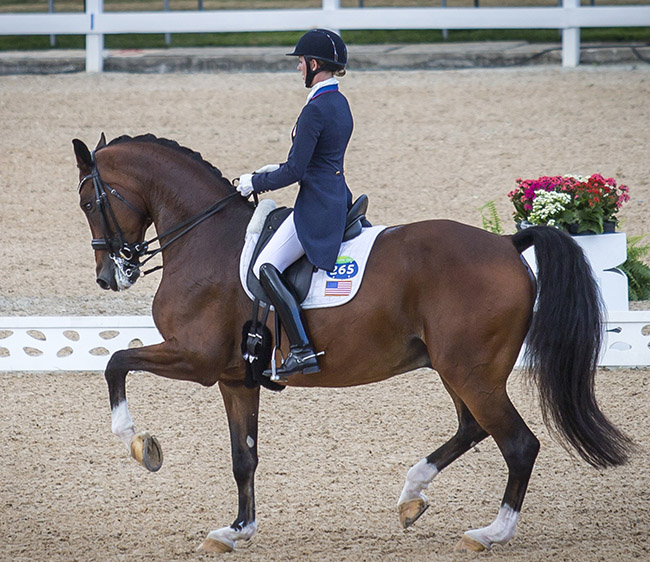
Ilse: What are your training ideas?
Laura: I think everyone has a system, but sometimes it is hard to put in words! My biggest focus every day on every horse is quality in the gaits. There are a lot of pieces included in this (being on my aids, connection, balance, etc.), but before I ask a horse to try a movement, I want the best gait that the horse can give me at that time. Of course the gaits improve as the horse gets stronger and learns to use his body. But by focusing on the quality of the basic gaits, he is able to develop properly through the exercises.
I have always felt good on a horse and have always been comfortable on a horse, but I am always training to be strong in the right places and quiet in that strength. It is something I work on every day and of course we are teaching the horses the same thing.
This article first appeared in the November 2014 issue of THM.
An update on what happened after 2014, from Debbie McDonald follows
It is a nice story in that Laura didn’t have mega-rich backing…
“Yes, and to be honest, unless she had somebody who came in and helped fund her coaching and training, it would have been very difficult for Laura to have done what she has done, on her own.
It is not an easy horse…
“Oh my gosh no. He’s hot, he’s sensitive, he’s very spooky. It is just a matter of channeling the energy in the right way and she knows that better than anyone – she’s had him since he was a foal. It hasn’t all been a story of success. It’s just in the last three or four years that things have started to move in the direction it’s gone now.”
Two crosses of Hackney – that’s smoking hot…
“Yeah – Debbie is giggling thinking about the horse – he’s very much of a cart horse, when you look at him, you think that’s kind of what he is, but then he moves and you go, oh my gosh! It’s crazy, it’s just crazy to watch.”
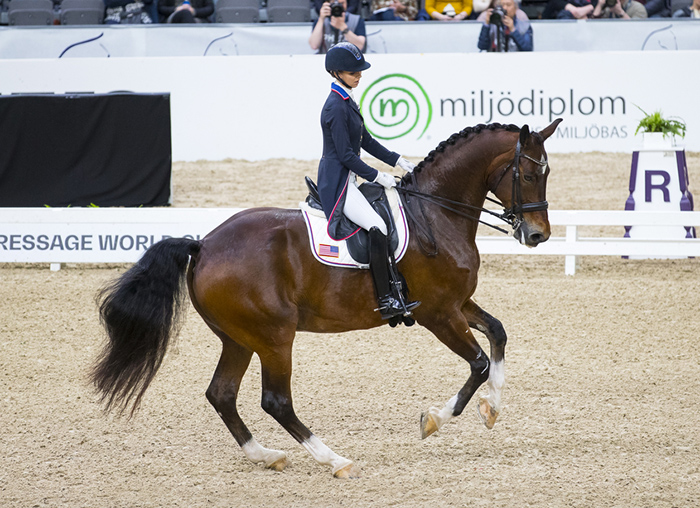
And Laura is back again, after the Grand Prix leg at the 2019 World Cup in Gothenburg, Laura and Diddy are just behind Isabell Werth and Weihegold.


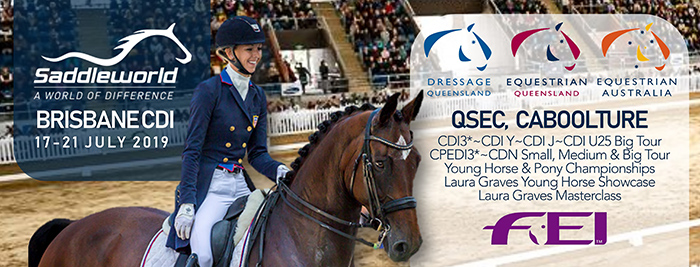
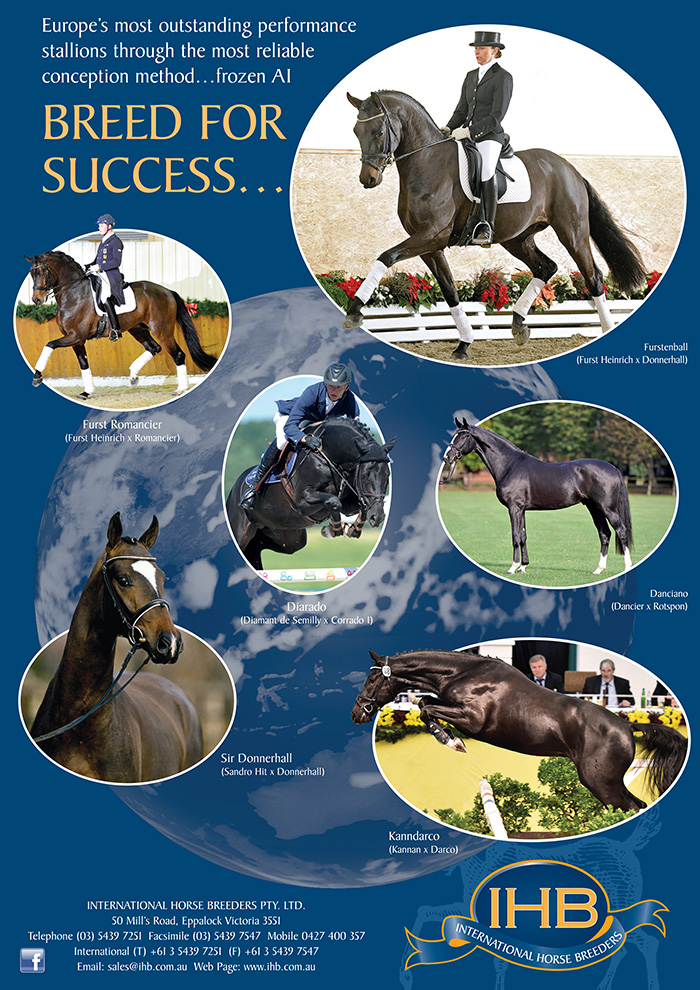
Wow I didn’t know any of that background, she has really paid her dues. Lovely story, she does us proud.